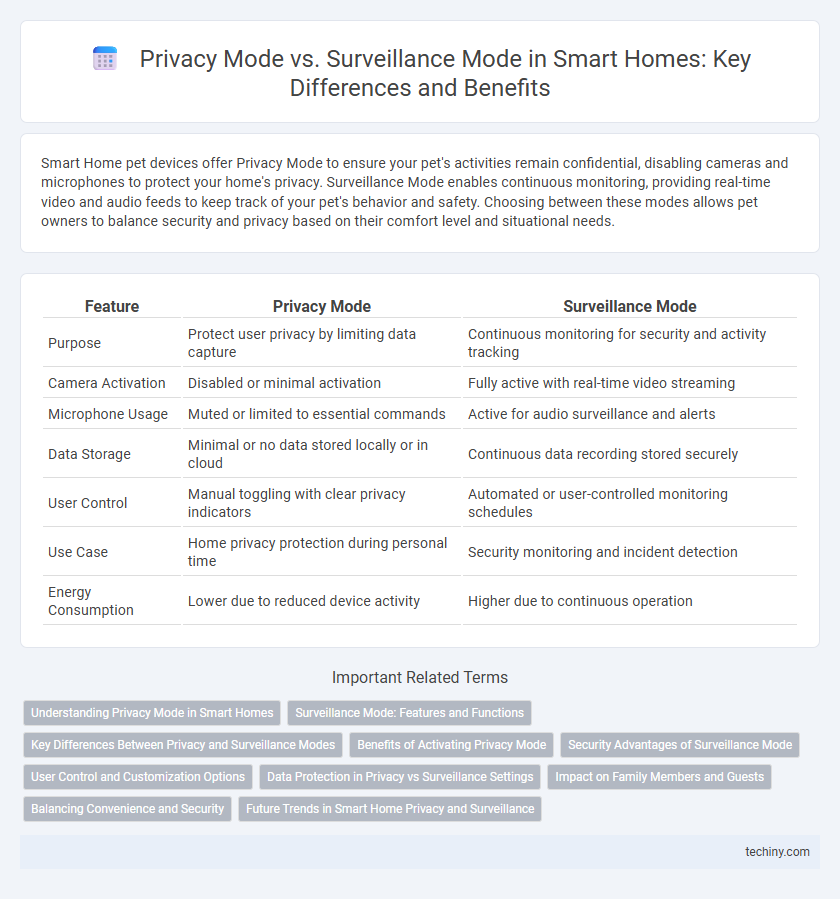Smart Home pet devices offer Privacy Mode to ensure your pet's activities remain confidential, disabling cameras and microphones to protect your home's privacy. Surveillance Mode enables continuous monitoring, providing real-time video and audio feeds to keep track of your pet's behavior and safety. Choosing between these modes allows pet owners to balance security and privacy based on their comfort level and situational needs.
Table of Comparison
| Feature | Privacy Mode | Surveillance Mode |
|---|---|---|
| Purpose | Protect user privacy by limiting data capture | Continuous monitoring for security and activity tracking |
| Camera Activation | Disabled or minimal activation | Fully active with real-time video streaming |
| Microphone Usage | Muted or limited to essential commands | Active for audio surveillance and alerts |
| Data Storage | Minimal or no data stored locally or in cloud | Continuous data recording stored securely |
| User Control | Manual toggling with clear privacy indicators | Automated or user-controlled monitoring schedules |
| Use Case | Home privacy protection during personal time | Security monitoring and incident detection |
| Energy Consumption | Lower due to reduced device activity | Higher due to continuous operation |
Understanding Privacy Mode in Smart Homes
Privacy Mode in smart homes prioritizes user data protection by restricting continuous audio or video recording and limiting data sharing with external servers. This mode often disables devices like cameras and microphones, ensuring sensitive activities remain private and reducing the risk of unauthorized access. Understanding Privacy Mode empowers homeowners to balance smart technology benefits with robust personal privacy control.
Surveillance Mode: Features and Functions
Surveillance Mode in smart homes provides 24/7 video monitoring with motion detection and real-time alerts to enhance security. It integrates with smart devices for automated recording and live streaming accessible via mobile apps, ensuring comprehensive home surveillance. Advanced features include facial recognition, cloud storage, and customizable activity zones for precise monitoring.
Key Differences Between Privacy and Surveillance Modes
Privacy Mode in smart homes prioritizes user data protection by disabling cameras and audio recording to prevent unauthorized monitoring. Surveillance Mode enables continuous video and audio capture for real-time security monitoring and evidence collection. The key difference lies in Privacy Mode safeguarding personal spaces, while Surveillance Mode enhances security through active observation.
Benefits of Activating Privacy Mode
Activating Privacy Mode in a smart home safeguards personal data by restricting sensor and camera access, minimizing the risk of unauthorized monitoring. It enhances user control over device functions, allowing selective disabling of features to maintain confidentiality within private spaces. Privacy Mode supports compliance with data protection regulations by limiting data collection and storage during sensitive moments.
Security Advantages of Surveillance Mode
Surveillance Mode in smart home systems offers enhanced security advantages by continuously monitoring and recording activity, which deters potential intruders and provides real-time alerts for suspicious behavior. This mode enables seamless integration with motion sensors, facial recognition, and cloud storage, ensuring immediate incident response and secure evidence retrieval. The constant vigilance furnished by Surveillance Mode significantly reduces blind spots and improves overall household safety compared to Privacy Mode.
User Control and Customization Options
Privacy Mode in smart home systems empowers users with granular control over data collection, allowing them to disable cameras and microphones to ensure personal spaces remain private. Surveillance Mode, by contrast, offers customizable monitoring settings that enable users to define specific areas and conditions for active recording, enhancing security without constant oversight. Both modes provide tailored user interfaces to adjust permissions and notifications, balancing privacy preferences with real-time surveillance needs.
Data Protection in Privacy vs Surveillance Settings
Privacy Mode in smart home devices prioritizes data protection by minimizing data collection and encrypting sensitive information to prevent unauthorized access. Surveillance Mode often involves continuous monitoring and storage of video or audio data, which increases the potential risk of data breaches and misuse. Implementing robust encryption protocols and user-controlled data access settings enhances security and ensures compliance with privacy regulations in both modes.
Impact on Family Members and Guests
Privacy Mode in smart homes limits data collection and disables continuous monitoring, fostering a secure environment where family members and guests feel respected and free from intrusive observation. Surveillance Mode enables extensive data capture and real-time monitoring, which can increase security but may cause discomfort or mistrust among residents and visitors. Balancing these modes directly impacts residents' sense of privacy, emotional well-being, and the overall atmosphere within the smart home.
Balancing Convenience and Security
Privacy Mode in smart home systems minimizes data collection and limits device access to protect user confidentiality, ensuring sensitive information remains private. Surveillance Mode maximizes monitoring capabilities, providing real-time security insights and alerts to enhance safety but may raise privacy concerns due to continuous data capture. Striking a balance between these modes involves customizing settings to meet individual comfort levels, optimizing both convenience and robust home security.
Future Trends in Smart Home Privacy and Surveillance
Future trends in smart home technology emphasize enhanced Privacy Mode features that empower users with granular control over data sharing and device activation, reducing unauthorized surveillance risks. Advances in AI-driven algorithms enable adaptive surveillance mode settings, balancing security needs with privacy concerns by dynamically adjusting monitoring based on user behavior and contextual awareness. Integration of decentralized data storage and blockchain technology further strengthens data privacy, preventing centralized breaches while maintaining transparent audit trails in smart home surveillance systems.
Privacy Mode vs Surveillance Mode Infographic

 techiny.com
techiny.com